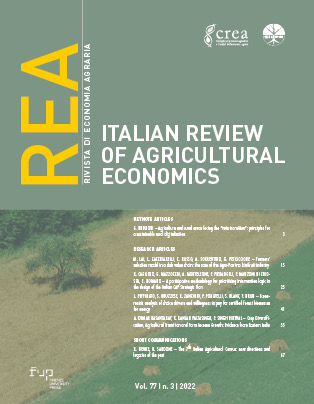Published 2022-11-25
Keywords
- farm structures,
- farm size,
- on-farm diversification,
- young farmers,
- contract services
How to Cite
Abstract
The release of the new Italian Agricultural Census shows many features in line with the previous decades and also some novelties, which shall be properly investigated in the upcoming future. The reduction in number of farms was largely announced and in line with the overall declining trend. However, in 2020 the average farm size has grown, showing a slowdown of land abandonment and soil consumption in agriculture and a reorganization of the farm structures. In this paper the main economic, social and functional transformations are analysed, by aggregating some of the most relevant trends in evidence. More in-depth analyses from scholars, stakeholders and policymakers are advocated, with the ultimate goal of highlighting and interpreting the long-term paths of Italian agriculture.
Downloads
References
- Aguglia L., Henke R., Salvioni C. (2009) (eds). Multifunctional agriculture. Entrepreneurial behaviours and strategies in the search for diversification. ESI, Napoli.
- Arzeni A., Pecci F. (2012). L’agricoltura che cambia: il sesto Censimento tra passato e futuro. Agriregionieuropa, 31: 3-5.
- Arzeni A., Sotte F. (2014). Agricoltura e territorio: dove sono le imprese agricole? QA-Rivista dell’Associazione Ross-Doria, 1: 75-100. DOI: 10.3280/QU2014-001003
- Cagliero R., Novelli S. (2012). Giovani e senilizzazione nel Censimento dell’Agricoltura. Agriregionieuropa, 31: 11-17.
- Cardillo C., Gaudio F., Pupo D’Andrea M.R., Sardone R. (2022). Censimento dell'agricoltura italiana 2020. Cosa emerge alla vigilia dell'avvio del Piano Strategico della PAC?. Pianeta PRS, 116, Settembre.
- Davis J., Caskie P., Wallace M. (2013). Promoting structural adjustment in agriculture: The economics of New Entrant Schemes for farmers. Food Policy, 40: 90-96. DOI: https://doi.org/10.1016/j.foodpol.2013.02.006
- De Benedictis M. (eds) (1992). Strategie familiari, pluriattività e politiche agrarie. Il Mulino, Bologna.
- Fabiani G., Scarano G. (1995). Una stratificazione socioeconomica delle aziende agricole: pluralismo funzionale e sviluppo territoriale. La Questione Agraria, 59: 27-91.
- Fanfani R., Montresor E. (2000). La struttura sociale dell’agricoltura italiana. Franco Angeli, Milano.
- Fanfani R., Sardone R. (2017). La diversificazione delle attività in agricoltura: opportunità, sviluppo dei redditi e nuove sfide della società, in Annali dell’Accademia Nazionale di Agricoltura, Volume CXXXVI, anno 2016, Bologna.
- Giacomini C. (2022). Poche sorprese nel Censimento dell’agricoltura. L’informatore Agrario, 27: 14-15.
- Henke R. (2004). Verso il riconoscimento dell’agricoltura multifunzionale. Teorie, politiche, strumenti. INEA Studi & Ricerche, ESI, Napoli.
- Henke R., Benos T., De Filippis F., Giua M., Pierangeli F., Pupo D’Andrea M.R. (2018). The new Common Agricultural Policy: how do Member States respond to flexibility? Journal of Common Market Studies, 56 (2): 403-419. DOI: https://doi.org/10.1111/jcms.12607
- Henke R., Povellato A. (2012). La diversificazione nelle aziende agricole italiane. Agriregionieuropa, 31: 24-29.
- Henke R., Povellato A., Vanni F. (2014). Elementi di multifunzionalità nell’agricoltura italiana: una lettura dei dati del Censimento. QA-Rivista dell’Associazione Rossi-Doria, 1: 101-133. DOI: 10.3280/QU2014-001004
- Henke R., Salvioni C. (2008). Multifunzionalità in agricoltura: sviluppi teorici ed evidenze empiriche. Rivista di Economia Agraria, LXII(1): 5-34.
- ISTAT, CREA (2022). Trends in the Italian Agricultural Economy and Legislation - Year 2021. https://www.istat.it/en/archivio/272571
- Mantino F. (eds) (1995). L’azienda agricola e dintorni. INEA, Studi & Ricerche, Roma.
- Marinelli A., Sabbatini M., Turri E. (1998). Le tipologie delle aziende agricole italiane tra professionalità e accessorietà. Rivista di Economia Agraria, 3: 55-74.
- Matthews A. (2021). Farm consolidation continues. www.capreform.eu.
- Ortiz-Miranda D., Moragues-Faus A., Arnalte-Alegre E. (2013). Agriculture in Mediterranean Europe: Challenging theory and policy, p. 295-310. In: Ortiz-Miranda D. Moragues-Faus, Arnalte-Alegre E. (eds) Agriculture in Mediterranean Europe. Emerald, Bingley, UK.
- Russo C. (2014). Il posizionamento strategico delle aziende agricole italiane. Una mappa concettuale basata sui risultati del VI Censimento Generale dell’Agricoltura. Economia e Diritto Agroalimentare, XIX: 5-35. DOI: 10.1400/226187
- Salvioni C., Henke R., Esposito L., Rondinella V. (2010). Diversification strategies in small farms in Italy. Economia e Diritto Agroalimentare, 3: 369-384.
- Sardone R., Monda M. (2019). Agricultural diversification: between knowledge needs and information gaps. Italian Review of Agricultural Economics, 74(2): 41-52. DOI: https://doi.org/10.13128/rea-10852
- Sargani G.R., Zhou D., Raza M.H., Wei Y. (2020). Sustainable entrepreneurship in the agricultural sector, the nexus of the triple bottom line measurement approach. Sustainability, 12(8), 3275, DOI: https://doi.org/10.3390/su12083275
- Sotte F. (2006). Imprese e non-imprese nell’agricoltura italiana. Politica Agricola Internazionale, 1: 13-30.
- Spinelli L., Fanfani R. (2012). L’evoluzione delle aziende agricole italiane attraverso cinquant’anni di censimenti (1961-2010). Agriregionieuropa, 8(31): 6-13.
- Van der Ploeg J.D., Roep D. (2003). Multifunctionality and rural development: the actual situation in Europe. In: Van Huylenbroeck G., Durand G. (eds.) (2003) Multifunctional agriculture. A new paradigm for European agriculture and rural development. Ashgate, Aldershot (UK) and Burlington, (VT, USA), p. 37-53.
- Van Huylenbroeck G., Durand G. (2003). Multifunctionality and rural development: a general framework. In: Van Huylenbroeck G., Durand G. (eds.) Multifunctional agriculture. A new paradigm for European agriculture and rural development. Ashgate, Aldershot (UK) and Burlington, (VT, USA), p. 1-16.


